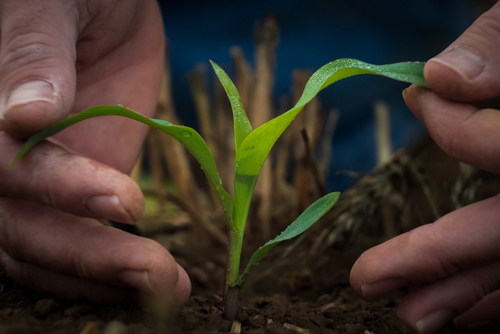The topic of sustainable agriculture continues to be present in the news and public policy, but what is it? The E4 team will get down to the basics of this subject and how certain aspects of sustainability can benefit your operation.
While there are several different perspectives about what sustainable agriculture really means and what purpose this agricultural system serves, the USDA does have a specific explanation. Sustainable agriculture is legally defined in U.S. Code Title 7, Section 3103, as an integrated system of plant and animal production practices having a site-specific application that sets out to achieve long term goals such as:
- Fulfilling human food needs
- Enhancing environmental quality and the natural resource base upon which the agricultural economy depends
- Make the most efficient use of nonrenewable resources and on-farm resources and integrate, where appropriate, natural biological cycles and controls
- Sustain the economic viability of farm operations
- Enhance the quality of life for farmers and society as a whole
From a 10,000-foot view, sustainable agriculture can be simplified as finding ways to meet the world’s present food needs without compromising the ability of current or future generations to meet their needs. So, while you may hear some talk about sustainability in a way that seems like we would be going back to farming practices of yesteryear, don’t ditch your tractor for an ox. The actual fundamental goal of the system is about utilizing resources and productive practices in a way that promotes environmental health, economic profitability, and social and economic equity.
As the Union of Concerned Scientists describes it, “Sustainable agriculture does not mean a return to either the low yields or poor farmers that characterized the 19th century. Rather, sustainability builds on current agricultural achievements, adopting a sophisticated approach that can maintain high yields and farm profits without undermining the resources on which agriculture depends.”
Why Is Sustainable Agriculture Important?
We will have more mouths to feed in the future. By 2050, the global population growth is expected to reach 10 billion people. The amount of farmland itself is diminishing due to urbanization and soil degradation. The Food and Agriculture Organization of the United Nations estimates that the world will lose about 250 million crop-production acres by mid-century.
As we’ve witnessed with the current fertilizer shortage, the unexpected (like the war in Ukraine) can impact access to finite resources and put growers in an unexpected bind. Phosphorous from phosphate rock is another nonrenewable resource that will have an impact on farming this century. It’s estimated that current global phosphate reserves could be depleted in the next 50-100 years and that peak phosphorous production will occur sometime around 2030.
Our world will always continue to change at a rapid pace. It’s our job as growers to ensure that agriculture remains viable for future generations despite the many challenges that we face in our industry.
While all this might seem like doom and gloom, it’s about recognizing what’s going on in the world around us and making changes for a better tomorrow. Sustainable agriculture can be a guiding light in the face of these challenges. It can help us maintain our soils, manage our resources, and meet consumer demand.
What Are Some Sustainable Agricultural Practices?
There are a number of different sustainable practices that growers can implement. We’ll dive into some that you could benefit from. But before you go on changing your whole operation, you should consult a trusted agronomy professional or firm (such as E4 Crop Intelligence) about whether or not the following practices are a good fit for you.
Soil Management
Soil is the lifeblood of crops. Managing the soil includes diminishing the possibility of erosion and evaluating its overall composition through testing. By taking care of the field, you can have better yields and healthier soil.
A big challenge in areas where hills and slopes are prevalent is runoff. Terraces can help reduce the amount of soil erosion. Buffer strips along hill depressions and waterways also minimize runoff.
A grower can monitor field health by conducting soil samples. These data-driven tests can reveal ways to improve yields through various approaches (potentially saving you money on inputs in the process). E4 Crop Intelligence provides in-depth and meticulous soil sampling services. This approach starts with taking soil core samples in an organized and consistent way where each core is deposited in a bag with a unique sample ID that coincides with specific GPS coordinates from the sample collection site. The process is repeated multiple times in precise areas of the field, and then the samples are sent to labs approved by E4. Once lab results are finalized, the data gathered can help the grower determine where nutrients need to be optimized (more on soil sampling here).
Crop Diversity and Rotation
The type of crops you use and when you use them plays a huge role in the health of your soil, crop performance, and overall cost of inputs. Depending on the type of crops you plant, your field can benefit from crop rotations. Rotating crops can reduce disease and pest severity, while also utilizing benefits of other species; for example, leaving a nitrogen credit for the next crop.
During off-season periods, growers can cultivate cover crops (rye, alfalfa, vetch, etc.) to provide coverage to the soil. By covering what would usually be bare ground, you can reduce the amount of erosion, cycle soil nutrients, and lessen weed pressure (lowering herbicide costs).
Precision Chemical Applications
Precision chemical application is a more strategic use of mechanical and biological controls to reduce the use of pesticides to control pest populations. Technology like Variable Rate Application (VRA) is one method of accomplishing precision application. This approach measures the productivity differences in the field. Then, it supplies the right amount of chemicals according to the specific needs of particular areas identified during the measurement process. VRA provides savings in the use of herbicides, better weed control, lower environmental impact, and increased crop productivity.
Precision Nutrient Management
Being conscious of nutrient applications in the field allows you to minimize risk and manage costs. Utilizing soil sample data, understanding weather conditions, and leveraging fertility programs together lead to better decision-making outcomes for managing nutrients.
E4 offers comprehensive nutrient management solutions. Along with the previously mentioned soil sampling services, the agronomic firm offers a fertilizer prescription service that formulates nutrient prescriptions to address each field’s unique conditions, using more than just those soil tests to establish fertilizer placement on a per-acre basis. E4’s independent crop consultants also work with you to factor in financial parameters like cost-per-acre budgets, resulting in custom fertilizer plans that work for your operation.
All in all, this overview of sustainable agriculture barely scratches the surface. Still, it highlights that there are benefits not only to you as a grower but also to future generations.
For more information about agricultural topics similar to this one or to learn more about the agronomic services that E4 Crop Intelligence provides, head on over to E4CropIntelligence.com.

